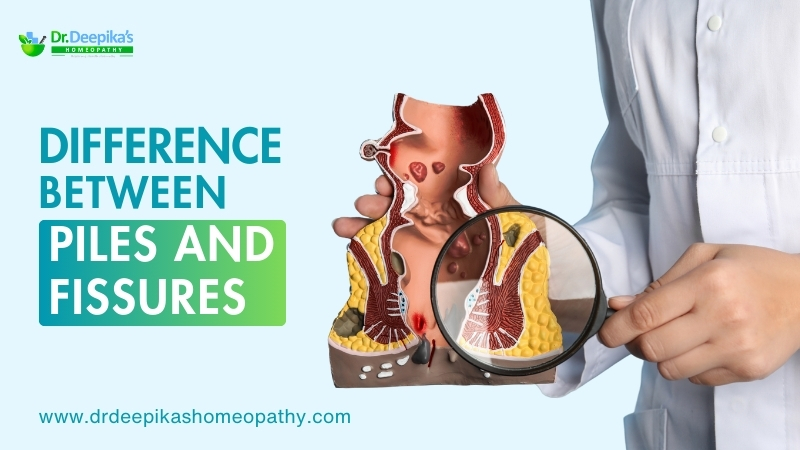
What is the Key Difference Between Piles and Fissures?
Most individuals suffer from anal pain and discomfort but are not sure if they have piles or fissures. Both occur in the anus and rectum but differ based on causes, symptoms, and treatment. Understanding the main difference between piles and fissures will assist in getting the correct treatment. Let’s discuss the conditions in detail, including the treatment of fissures and how it differs from the treatment for fissures.
What are Piles?
Piles, or hemorrhoids, are inflamed veins that appear in the anus or rectum. They can be external or internal and produce pain, discomfort, itching, and occasional bleeding. Piles occur as a result of increased pressure on the veins of the lower rectum, usually because of constipation, straining during defecation, sitting for long periods, or pregnancy.
What are Fissures?
Fissures, or anal fissures, are small cuts or tears in the lining of the anus that result in pain and bleeding with bowel movements. They result from straining too hard, passing hard stools, or injury to the anal canal.
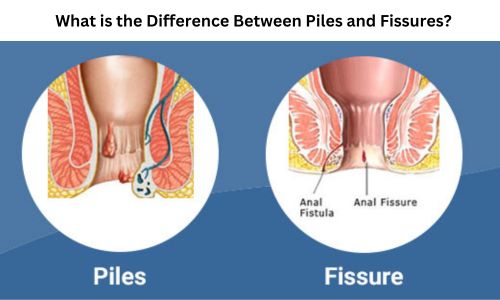
Types of Piles and Fissures
Piles are of internal, external, and thrombosed varieties with presenting symptoms such as bleeding, pain, and swelling. Prolapsed piles bulge out outside the anus. Fissures are anal tears that are painful, classified into acute, which heals soon, and chronic, which might need prolonged treatment. Both conditions are very painful but can be managed effectively.
Types of Piles
Piles, or hemorrhoids, are engorged blood vessels near the anus or rectum. They are graded according to size, severity, and complications.
- Internal Piles
Internal piles are within the rectum and are often symptomless. They can present with symptoms such as bleeding on passing motions, discharge of mucus, and sensation of incomplete emptying. These piles are graded into four categories depending on severity:
Grade 1: Small prolapsed hemorrhoids with painless bleeding.
Grade 2: Prolapsing hemorrhoids on defecation but receding spontaneously.
Grade 3: Pro-ward prolapsed hemorrhoids that need to be manually reduced.
Grade 4: Grossly prolapsed hemorrhoids that remain outside the anal canal and usually need surgical intervention.
- External Piles
External piles develop below the skin at the region around the anus and are more painful than internal piles because the area has sensitive nerves. The signs include:
- Pain and discomfort, especially during defecation.
- Irritation and itching in the anus area.
- Swelling or bulge at the anus.
- Bleeding, particularly if the hemorrhoid is ruptured or inflamed.
- Prolapsed Piles
Proximal piles are internal hemorrhoids that have protruded beyond the anus, often during or after a bowel movement. They may be manually replaced inside or else stay outside in more extreme conditions, causing pain and bleeding.
- Thrombosed Piles
Thrombosed piles take place when there is clot formation within a skin-covered external hemorrhoid that brings about a bluish painful swelling near the anus. These piles are so painful and will most likely necessitate medical intervention.

Types of Fissures
An anal fissure is an actual tear or a crack in the anal skin, usually followed by pain and pain in passing bowel movements. Fissures are categorized on the basis of duration and intensity:
- Acute Fissures
Acute fissures are new tears in the lining of the anus, typically due to passing hard stools or constipation. Acute fissures are usually painful and sharp during bowel movements but heal spontaneously within a few weeks with good care. Symptoms of acute fissures are:
- Sharp pain on or after bowel movements.
- Mild bleeding (bright red) on bowel movements.
- A tiny crack or tear in the skin surrounding the anus.
- Chronic Fissures
Chronic fissures are prolonged tears that do not heal in the normal time period, typically taking longer than six weeks. Chronic fissures are more painful and need medical treatment to help them heal. They can be very uncomfortable, and if they are not treated, they can result in skin tags or anal fistulas. The symptoms of chronic fissures are:
- Continued, severe pain with and after bowel movements.
- Itching or itching around the anus.
- Swelling or development of skin tags along the fissure.
- Chronic bleeding on passage of stools.
- Posterior Fissures
The most common among them is posterior fissures, occurring at the rear of the anus. Posterior fissures occur more often among adults and children. They may be acute or chronic, with symptoms depending on the severity and duration. Intense pain, bleeding, and discomfort are typical symptoms.
- Anterior Fissures
Anterior fissures occur at the anterior part of the anus, more frequently in women, particularly in pregnancy. They are less frequent than posterior fissures but are still very painful and uncomfortable. The symptoms are the same as for posterior fissures, with severe pain and bleeding on defecation.
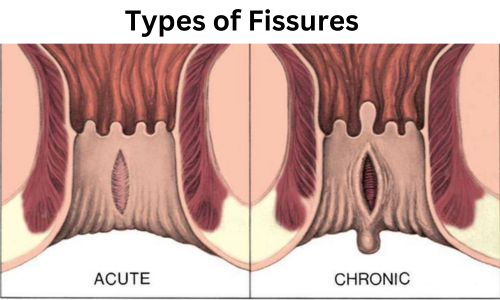
Symptoms of Piles and Fissures
Symptoms of piles are painless bleeding, itching, swelling, and pain in the anus. External piles produce palpable lumps, whereas internal piles can cause prolapse and discharge of mucus. Fissures produce cutting pain on defecation, bleeding, itching, and pain, with chronic fissures being more painful and persistent.
Symptoms of Piles
Internal Piles:
- Bleeding from the rectum without pain (bright red blood on toilet paper or in stool).
- Discharge of mucus following defecation.
- The feeling of incomplete evacuation.
- Discomfort during later stages of prolapsed hemorrhoids.
External Piles:
- Pain and discomfort in the anal area.
- Swelling or mass around the anus.
- Itching and irritation in the anal region.
- Bleeding in severe cases.
- Thrombosed piles (bluish swelling with severe pain due to clotting).
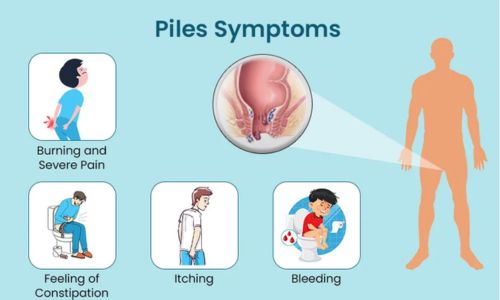
Symptoms of Anal Fissures
- Severe pain on or after bowel movement.
- Bright red blood on the stool or toilet tissue.
- Visible tear or fissure close to the anus.
- Burning or itching pain in the anal region.
- Swelling or small lump (skin tag) close to the fissure in long-standing cases.
- Pain when sitting for a long time.
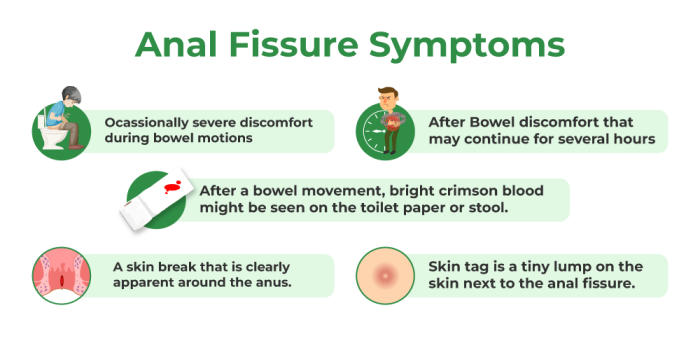
Causes of Piles and Fissures
Piles and fissures are usually brought about by constipation, straining to pass stools, a low-fiber diet, or spending long periods of time sitting. Other causes include obesity, pregnancy, and anal trauma. Piles are also caused by increased pressure on veins, whereas fissures are caused by trauma to the lining of the anus, usually because of hard stools.
Causes of Piles
- Chronic constipation – Straining on the stool puts pressure on rectal veins.
- Chronic diarrhea – Frequent stools irritate the rectal area.
- Prolonged sitting – Prolonged sitting, particularly on the toilet, puts pressure on veins.
- Low-fiber diet – Creates hard stools and straining.
- Obesity – Weight gain places extra pressure on rectal veins.
- Pregnancy – Added abdominal pressure and hormonal changes lead to vein swelling.
- Heavy lifting – Recurrent lifting of heavy weights may cause strain on rectal veins.
- Aging – Weakening of tissues over time makes piles more probable.
- Genetic factors – Family history could predispose to it.
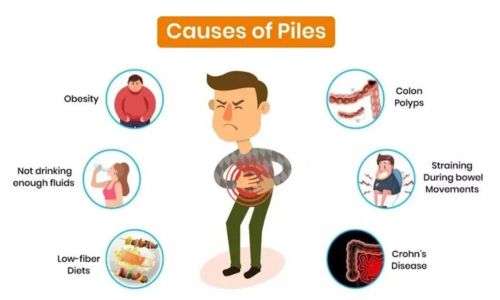
Causes of Fissure
- Chronic constipation – Passing hard stools may cause the anal lining to tear.
- Chronic diarrhea – Repeated bowel movements weaken and irritate the anal tissue.
- Straining on the bowel – Puts pressure on the anal canal, causing tears.
- Low-fiber diet – Causes hard stools, which are painful to pass.
- Anal trauma – Trauma from childbirth, anal intercourse, or surgery.
- Inflammatory conditions – Conditions such as Crohn’s disease and ulcerative colitis weaken the anal tissue.
- Inadequate blood circulation – Decreased blood supply to the anal region delays healing.
- Long sitting – Long sitting elevates pressure over the anal region.
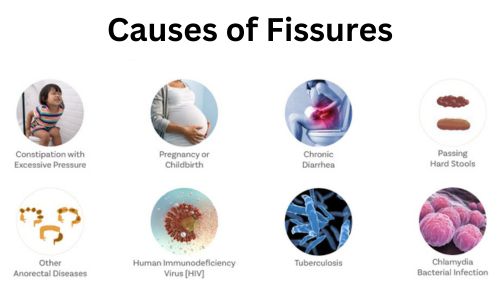
Homeopathy Treatment for Piles and Fissures
Homeopathy may give mild, natural relief for fissures and piles by treating the underlying cause, lessening inflammation, and facilitating healing. Some of the most popular homeopathic treatments are listed below:
Homeopathy Treatment for Piles
- Aesculus hippocastanum
Relieved by hemorrhoids with pain, particularly when accompanied by a feeling of fullness in the rectum along with a sense of pressure or throbbing.
- Hamamelis virginiana
Beneficial for hemorrhoids with soreness and bleeding. It relieves soreness and inflammation around the anus.
- Ratanhia
Recommended for severe pain on and after passing stools, especially if the pain is a sharp, burning one.
- Nux vomica
Suitable for individuals with piles due to a sedentary lifestyle, constipation, or excess food and alcohol consumption.
- Calcarea fluorica
A medicine for prolapsed hemorrhoids, with a predisposition to form hard lumps near the anus.
Homeopathy Treatment For Fissures
- Graphites
Beneficial for painful fissures of the anus, particularly when the skin is cracked and thickened with bleeding.
- Nitric acid
Best suited for fissures that are characterized by severe pain and a sense of splinter or knife-cutting sensation upon or after passing stools.
- Ratanhia
Beneficial also for fissures, particularly when there is cutting, knife-like pain that remains even after the passage of stool.
- Arsenicum album
Beneficial for fissures with burning, itching, and restlessness.
- Mercurius solubilis
Recommended for painful fissures that are inflamed and bleed easily.
Disclaimer
Consult a Trained homeopath before trying remedies for piles and fissures. Outcomes are unclear, and expert opinion is advisable in case of severe or recurring symptoms.
Consult with Dr. Deepika
Dr. Deepika is a specialist in treating piles and fissures using homeopathy, providing customized, non-surgical remedies for relieving pain, swelling, and discomfort. With her emphasis on overall healing, she treats the cause of the problem rather than just the symptoms.
Case Study 1: One patient with Grade 3 piles showed marked relief from pain and no bleeding within 3 months of treatment.
Case Study 2: A young mother suffering from anal fissures recovered in weeks with Dr. Deepika’s treatments.